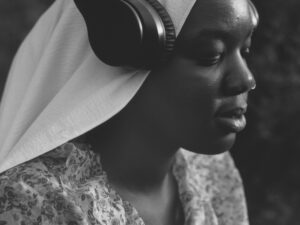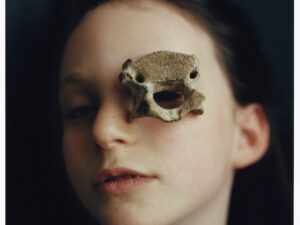Self-taught photographer Donavon Smallwood (b. 1994) lives close to Central Park in New York. Like many residents during the lockdown in 2020, he took frequent walks around the park’s green spaces. Over time, these strolls evolved into a series of portraits; Smallwood had began photographing local people who were using the environment as a retreat. The resulting series, titled Languor, presents “candid and instructed portraits of Black people at ease in nature.” It’s now on show as part of National Portrait Gallery’s Taylor Wessing Photographic Portrait Prize, this year taking place at Cromwell Place, London.
Whilst researching the series, Smallwood discovered the history of Seneca Village, an area situated on the margins of New York City. During the 19th century, it was home to an African American community, whose buildings were ultimately torn down to make way for present-day Central Park. For Smallwood, this was a profound discovery: “this place that I’d been coming to, that had been like a second home for me, was a literal home that was stripped from people and turned into a natural space that I was enamoured with.”
A: You began this series of portraits during the 2020 lockdown in New York. When, and how, did the idea for the project come to you? Was there a distinct moment that inspired the series?
DS: The idea came as a culmination of literature I was reading: the writings of William Blake and Johann Hamann, mixed with research I was conducting on Seneca Village.
A: Seneca Village was a 19th century African American community situated on the margins of the city. In 1857, the villagers were ordered to leave for the construction of present-day Central Park. Can you tell us a bit more about this, and how it influenced your project?
DS: I was learning about Seneca Village at the same time I was reading William Blake and fleshing out thoughts on the idea of ‘man vs. nature’. With Seneca Village, I learned that green spaces were given priority over people. For me, this signified a stripping of the community’s humanity — a humanity that was self-earned and expressed because it was never given in the first place. All these thoughts and readings were swirling through my head when I strolled through the park looking for these images.
A: The images capture local people you encountered whilst walking in Central Park. How did you choose your subjects? How much choreography was involved?
DS: I chose the subjects based on feeling and character – people with distinctive styles who seemed open to being photographed in a way that would lend itself to the type of portraits I was looking to make. There was not much choreography involved, just simple instructions such as “turn this way or that way.”
A: You have described these photographs as “candid and instructed portraits of Black people at ease in nature.” Why was it important to you to capture your participants amongst green spaces?
DS: Green spaces and nature are where I find solace and comfort. They are where I prefer to be and work. Creating images of serenity – which I feel aren’t seen enough – was the goal.
A: How do you define Languor?
DS: I like to visualise the word with a scenario. I think of someone going on a long hike to the top of a quiet mountain. When they make it to the top, they’re exhausted yet ecstatic as they watch the sun rise.
A: Is there a significance to your use of black and white?
DS: Black and white focuses attention on details, expressions and quality rather than distractions like colourful shirts or backgrounds – which don’t reflect the feeling the images are designed to give.
A: The series has been a great success, winning the 2021 Aperture Portfolio Prize. It’s now part of the Taylor Wessing Photographic Portrait Prize. How does it feel?
DS: It feels great, thank you! The end goal of the project was the creation of a photobook, which is available for pre-sale through the publisher Trespasser. To have any recognition and success outside of that means more to me than I could put into words.
A: What’s next for you? Are there any plans to develop the project, or start something new?
DS: I’m always photographing and working at a few things at a time, with a decent amount of projects in various stages of completion. One project I’m focusing on now is called Beebe; it’s an examination of my own ancestry.
The Taylor Wessing Photographic Portrait Prize is one of the most prestigious photography awards in the world, celebrating the very best in contemporary portrait photography. The exhibition takes place at Cromwell Place, London, until 2 January 2022. npg.org.uk
All images courtesyDonavon Smallwood, from the series Languor.









